


中国农业科学院作物科学研究所首次分析了小麦太谷核不育基因Ms2的基因结构,并注释了Ms2基因的结构功能。研究人员发现Ms2等位基因的ms2基因突变,使末端重复反转录转座子(TRIM)插入启动子中,激活了另一个Ms2等位基因,可导致雄性不育。Ms2基因分析结果不仅揭示了一个历史上重要的繁殖性状的遗传基础,也为科学研究提供了一个使用TRIM插入元件,构建新基因和塑造基因表型的方法。
太谷核不育小麦是我国科技人员高忠丽于1972年在山西太谷发现的一个显性核不育小麦材料,是由单显性核基因控制的自然突变体,其特点是雄性败育稳定彻底,不受环境条件影响,异交结实率高。它是进行小麦轮回选择的理想材料。
中国农业科学院作物科学研究所(以下简称作科所)自上世纪就开始了对太谷核不育材料的研究,且硕果频出。作科所研究员刘秉华通过杂交构建了矮秆基因和太谷核不育基因紧密连锁的矮败小麦,该材料的利用大大提高了小麦育种效率。
作科所研究员贾继增、孔秀英研究团队对该基因的克隆工作已开展了近20年,近期在克隆与解析小麦太谷核不育基因Ms2方面获得突破性进展。今年4月24日,孔秀英在第13届国际小麦遗传大会上应邀作了大会报告,首次公开报道了该基因。相关研究论文已于5月12日在《Nature Communications》杂志发表。文章以作科所为第一完成单位,作科所夏川、张立超、邹枨为共同第一作者,孔秀英和贾继增为共同通讯作者。山东农业大学付道林课题组也克隆了该基因并在同一杂志发表。
太谷核不育基因Ms2的克隆存在3个巨大的挑战:一是Ms2所在的4D染色体是小麦21条染色体中多态性最低的一条染色体;二是矮败小麦中Ms2基因所在区段重组率非常低;三是2012年之前无小麦参考基因组序列发表。矮败小麦是一个理想的轮回选择育种材料,但该材料不适合用于Ms2基因的图位克隆。研究团队最初选择了用矮败小麦构建图位克隆的群体,本想“一箭双雕”。然而当染色体步移到一定程度时,发现再也无法继续前进。
进一步研究才发现,这是由于矮秆基因所在基因组片段是一个1Mb 以上的串联重复,导致该区段的重组被严重抑制。为了增加4DS染色体的多态性及提高太谷不育基因区段的重组率,研究人员又用正常株高的太谷核不育材料与多样性高的人工合成小麦Am3杂交,重新配制分离群体,解决了重组问题与多样性低的问题。为了解决参照基因组的问题,他们绘制了小麦D基因组的框架图,使得小麦太谷核不育基因克隆的速度得以大幅度提升,最终成功地克隆了Ms2基因。
研究发现,该基因没有保守的功能结构域,是仅存在于小麦族物种中的孤儿基因;Ms2的产生经历了一个比较复杂的进化过程;一个新的非自主型的TRIM反转录转座子插入到Ms2基因的启动子区,激活了该基因并使其在花药中特异表达,导致不育表型的产生;Ms2-TRIM插入只影响基因的表达,这与该团队以前在矮秆基因Rht3中鉴定的CAAS-TRIM插入引起基因结构改变不同,表明TRIM插入到基因附近增加了基因新功能和表型的可塑性;D基因组的Ms2-TRIM可能来自B基因组的5BL;该研究结果表明小麦多倍体化和富含转座子的特点为产生新的表型提供了丰富的遗传变异基础。
该研究得到了国家重点研发计划、转基因生物新品种培育重大专项、国家重点基础研究发展计划(“973”计划)、国家“863”计划和中国农业科学院科技创新工程等项目资助。(来源:生物通)
A TRIM insertion in the promoter of Ms2 causes male sterility in wheat
Abstract The male-sterile ms2 mutant has been known for 40 years and has become extremely important in the commercial production of wheat. However, the gene responsible for this phenotype has remained unknown. Here we report the map-based cloning of the Ms2 gene. The Ms2 locus is remarkable in several ways that have implications in basic biology. Beyond having no functional annotation, barely detectable transcription in fertile wild-type wheat plants, and accumulated destructive mutations in Ms2 orthologs, the Ms2 allele in the ms2 mutant has acquired a terminal-repeat retrotransposon in miniature (TRIM) element in its promoter. This TRIM element is responsible for the anther-specific Ms2 activation that confers male sterility. The identification of Ms2 not only unravels the genetic basis of a historically important breeding trait, but also shows an example of how a TRIM element insertion near a gene can contribute to genetic novelty and phenotypic plasticity.
原文链接:http://www.nature.com/articles/ncomms15407
Wheat Ms2 encodes for an orphan protein that confers male sterility in grass species
Abstract Male sterility is a valuable trait for plant breeding and hybrid seed production. The dominant male-sterile gene Ms2 in common wheat has facilitated the release of hundreds of breeding lines and cultivars in China. Here, we describe the map-based cloning of the Ms2 gene and show that Ms2 confers male sterility in wheat, barley and Brachypodium. MS2 appears as an orphan gene within the Triticinae and expression of Ms2 in anthers is associated with insertion of a retroelement into the promoter. The cloning of Ms2 has substantial potential to assemble practical pipelines for recurrent selection and hybrid seed production in wheat.
原文链接:http://www.nature.com/articles/ncomms15121



